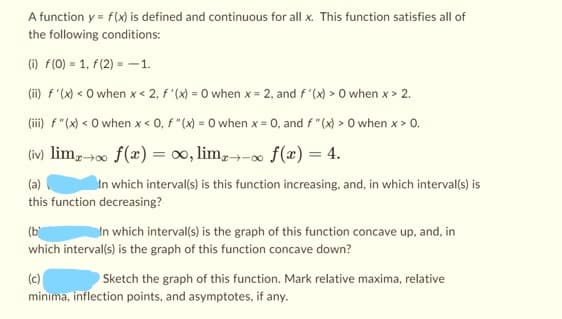A function y = f(x) is defined and continuous for all x. This function satisfies all of the following conditions: (i) f(0) = 1, f(2)=-1. (ii) f'(x) < 0 when x < 2, f'(x)=0 when x = 2, and f'(x) > 0 when x > 2. (iii) F"(x) < 0 when x < 0, f"(x) = 0 when x = 0, and f"(x) > 0 when x > 0. (iv) limx→∞ f (x) = ∞, limx→∞ f(x) = 4. (a) In which interval(s) is this function increasing, and, in which interval(s) is this function decreasing? (b) In which interval(s) is the graph of this function concave up, and, in which interval(s) is the graph of this function concave down? (c) Sketch the graph of this function. Mark relative maxima, relative minima, inflection points, and asymptotes, if any.
A function y = f(x) is defined and continuous for all x. This function satisfies all of the following conditions: (i) f(0) = 1, f(2)=-1. (ii) f'(x) < 0 when x < 2, f'(x)=0 when x = 2, and f'(x) > 0 when x > 2. (iii) F"(x) < 0 when x < 0, f"(x) = 0 when x = 0, and f"(x) > 0 when x > 0. (iv) limx→∞ f (x) = ∞, limx→∞ f(x) = 4. (a) In which interval(s) is this function increasing, and, in which interval(s) is this function decreasing? (b) In which interval(s) is the graph of this function concave up, and, in which interval(s) is the graph of this function concave down? (c) Sketch the graph of this function. Mark relative maxima, relative minima, inflection points, and asymptotes, if any.
Trigonometry (MindTap Course List)
10th Edition
ISBN:9781337278461
Author:Ron Larson
Publisher:Ron Larson
ChapterP: Prerequisites
SectionP.6: Analyzing Graphs Of Functions
Problem 6ECP: Find the average rates of change of f(x)=x2+2x (a) from x1=3 to x2=2 and (b) from x1=2 to x2=0.
Related questions
Question
plz provide handwritten step by step answer within 10 min

Transcribed Image Text:A function y = f(x) is defined and continuous for all x. This function satisfies all of
the following conditions:
(i) f(0) = 1, f(2)= -1.
(ii) f'(x) < 0 when x < 2, f'(x) = 0 when x = 2, and f'(x) > 0 when x > 2.
(iii) f "(x) < 0 when x < 0, f "(x) = 0 when x = 0, and f "(x) > 0 when x > 0.
(iv) limx→∞ f (x) = ∞, limx→∞ f(x) = 4.
(a)
In which interval(s) is this function increasing, and, in which interval(s) is
this function decreasing?
(b
In which interval(s) is the graph of this function concave up, and, in
which interval(s) is the graph of this function concave down?
(c)
Sketch the graph of this function. Mark relative maxima, relative
minima, inflection points, and asymptotes, if any.
Expert Solution
This question has been solved!
Explore an expertly crafted, step-by-step solution for a thorough understanding of key concepts.
Step by step
Solved in 3 steps with 2 images

Recommended textbooks for you

Trigonometry (MindTap Course List)
Trigonometry
ISBN:
9781337278461
Author:
Ron Larson
Publisher:
Cengage Learning

Trigonometry (MindTap Course List)
Trigonometry
ISBN:
9781337278461
Author:
Ron Larson
Publisher:
Cengage Learning